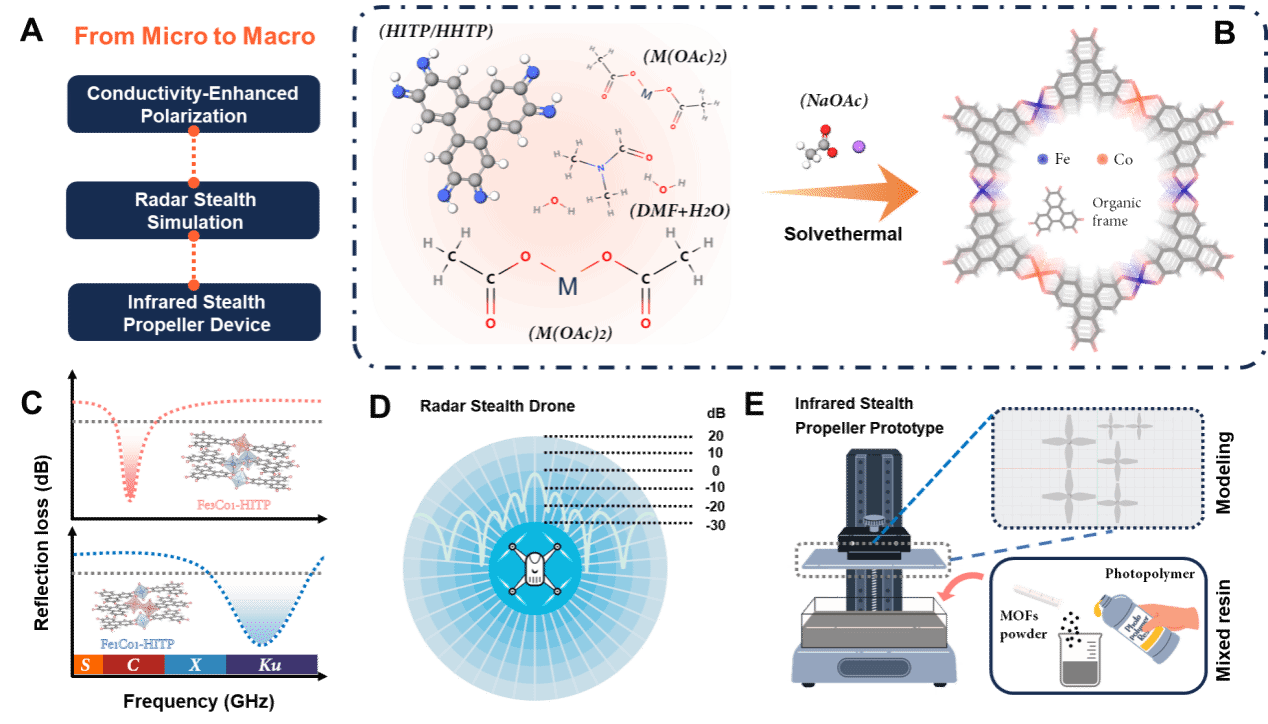Recently, guided by Associate Professor Cheng Junye from Shenzhen MSU-BIT University Material Science Department, Jin Yongheng, a special-program master student from Beijing Institute of Technology & Shenzhen MSU-BIT University published his research paper titled with Conductance Reinforced Relaxation Attenuation with Strong Metal-N Coordination in Multivariate π-Conjugated MOFs for Integrated Radar-Infrared Camouflage in Advanced Materials as the first author and with Shenzhen MSU-BIT University as the primary institution. Jiang Shan, Zou Xingjian, Guo Junjie and Ren Zhengyang, undergraduates from Shenzhen MSU-BIT University Material Science Department, and Chen Qingkui, a special-program master student and Zhang Zhaosong, a PhD student from Beijing Institute of Technology & Shenzhen MSU-BIT University also attended this research. Professor Chen Renchao from Fudan University provided material characterization technology support for this research.

With the rapid integration of low-altitude economy with emerging scenarios including smart city, emergency logistics and 3D transportation, environmental adaptability, spectrum compatibility and all-weather operation capability of UAVs - core carriers of low-altitude intelligent equipment have become critical bottlenecks in the industrial advancement. Under such background, the advanced functional materials with structural programming and dynamic electromagnetic response regulation capabilities become an important breakthrough to overcome UAVs’ bottleneck in adaptability to complex environment and guarantee the sustainable development of low-attitude industry.
Owing to outstanding conductivity and structural adjustability, the conductive metal organic frameworks (MOFs) have become the promising candidates in the fields of electromagnetic functional materials and electromagnetic radiation control materials. However, the effective regulation of their dielectric properties and the systematic explanation of their acting mechanisms remain typical scientific issues. This research proposed an electromagnetic response optimization strategy for conductive MOFs, integrating component unit regulation, electrodynamic regulation and advanced 3D technology together and achieving the coordinated optimization of cross-scale properties of materials. By strengthening the π-d conjugation effect, precisely regulating the metal-ligand coordination structures and introducing the conductivity-enhanced relaxation attenuation mechanism, both conductive loss and dielectric polarization of MOFs were improved significantly, resulting in the excellent microwave absorption performance. With a thickness of 2mm, the material realized the 6.0 GHz broadband absorption bandwidth. With a thickness of 3.5mm, the minimum reflection loss of the material is low to -46.7 dB.

Fig. 1 Hydrothermal synthesis method and radar-infrared camouflage design strategy of conductive MOFs
Furthermore, the propeller components made from light-cured 3D printed conductive MOFs are capable of absorbing microwaves and suppressing infrared radiations, with the maximum radar cross section (RCS) attenuation of -23.3 dB㎡ and the infrared emissivity low to 0.203; after 30min continuous heating on a 100℃ platform, their surface temperature remains below 50 ℃, demonstrating their outstanding heat management capability and environmental stability. The developed functional components can be used as key components of UAVs to strengthen their camouflage and mission reliability in the complex environment featured with intense electromagnetic interference and multi-spectral detection. This research established a full-flow technical route from molecular-scale design to macroscopic component fabrication, providing references for design, technology and engineering application of the next generation of high-performance integrated radar-infrared camouflage components, strengthening the understanding of electromagnetic property regulation mechanism of conductive MOFs, and offering theoretical supports to the extended application of MOFs in the multi-functional camouflage field.

Fig. 2 Infrared camouflage evaluation of conductive MOFs-based UAV propeller components
This research was is funded and supported by the National Key Research and Development Program of China, the NSFC General Program, the Aeronautical Science Fund of China, the Key Researches and Development Program Fund of the Department of Education of Guangdong Province, the High Temperature Electromagnetic Material and Structure Key Laboratory Fund of the Ministry of Education of China, the Open Research Fund of the National Key Laboratory of New Ceramic Materials of Tsinghua University, the Stability Support Program of Shenzhen City, the Shanghai Science & Technology Commission Program and the National Defense Technology Key Laboratory Fund for Surface Physics and Chemistry.
Link to the paper:
https://advanced.onlinelibrary.wiley.com/doi/10.1002/adma.202501330